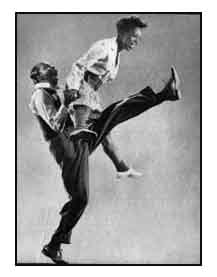
Music: New musical
styles tend to inspire new dance styles. Music for swing dance varies in tempo
(deviations of as little as 20 beats per minute, or less, seem to give a different
"feel"), texture (small to large ensemble, as well as instrumentation),
and attitude(smooth, to funky, to gritty). Big Band Swing, Jump Swing,
Jump Blues, Rockabilly, Doo Wop, Piano Boogie, Guitar Boogie, and Rhythm & Blues
are the current musical styles for swing dance. There are some who enjoy (gasp!)
Disco & Funk tunes for West Coast Swing and Shag, but those who are appalled
far outweigh the rebels. (I say: "Whatever!") Anyway, dance styles reflect
these musical genres. 
Origins: Swing dance locates its roots in the spontaneous dances of gifted improvisers to the music of Ragtime Piano, Jump Blues, and Dixieland at the turn of the century. "The South" is the region of origin for this music, and hence the ultimate region of origin for swing dance.
Many popular partner dances of the western hemisphere owe their birth to creative and talented people of African origin: not only Swing, but also Tango and Salsa! The wild jumps, kicks, and goofy jazz moves of Lindy Hop, as well as the sleek, subtle, sexy "latin styling" of West Coast Swing are clearly traceable to black genius . Let us consider the anonymous individuals who, independently of each other, adapted European social dance partnering ideas (both courtly and folk) to free, expressive African movement. Swing music and Swing dance are precisely the marraige of African and European approaches to both.
In addition, those so inclined drew upon the vast repertoire of complex footwork from the Irish and Balkan folk traditions. How are these influences transmitted? Moderately gifted dancers might see something only once for it to enter their repertoire. Seeing into the principles of the movements, they proceed to create totally new ones. These people don't need unending rounds of classes!
Dancers: Willa Mae Ricker & Leon James, 1943
More?
SWING DANCE: Development